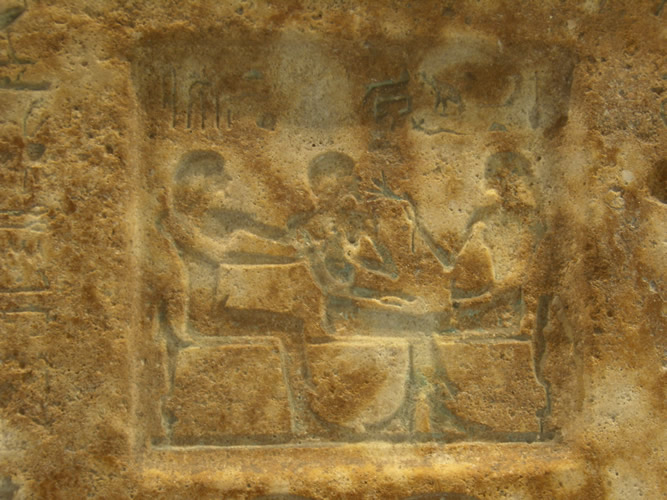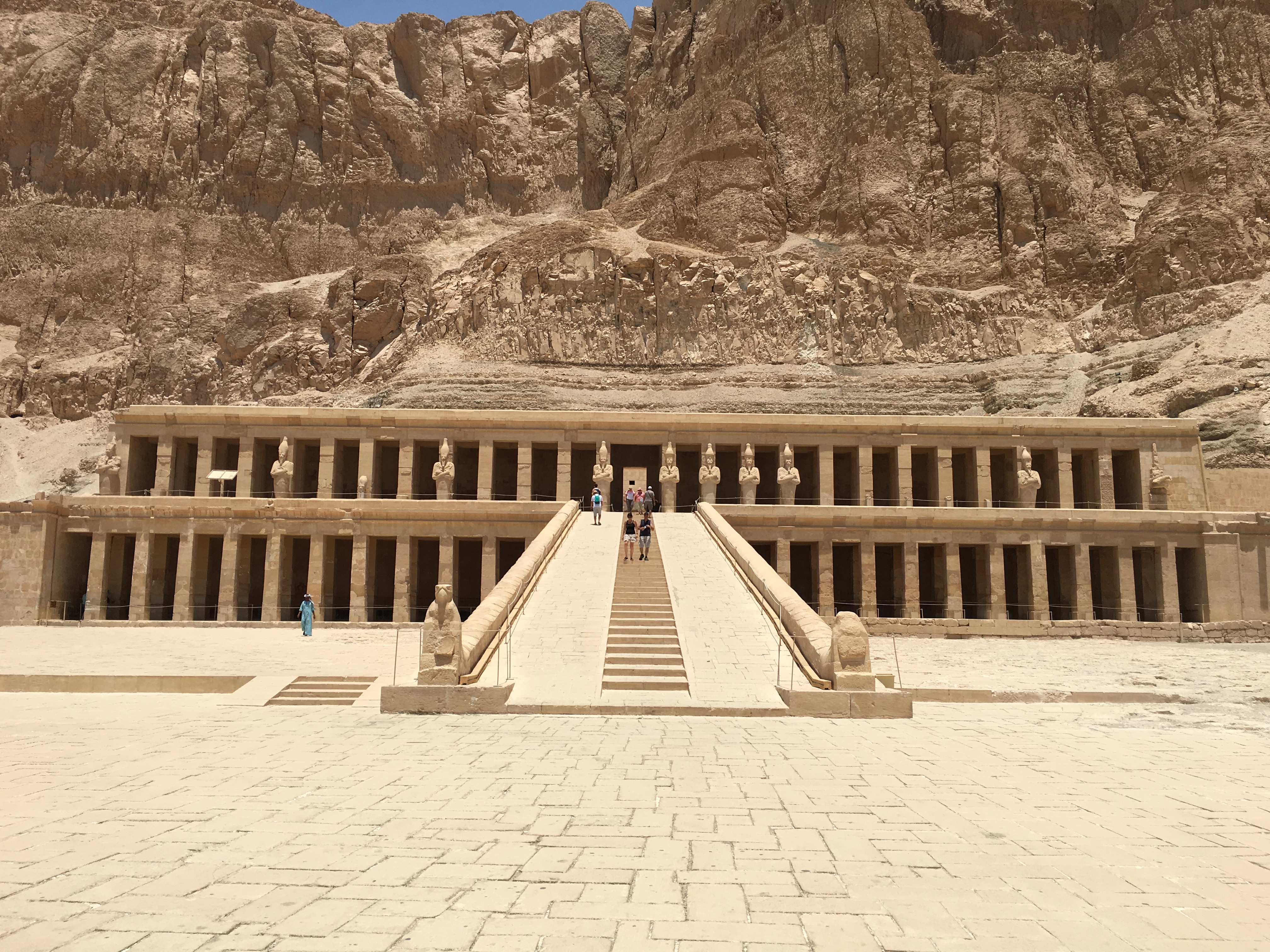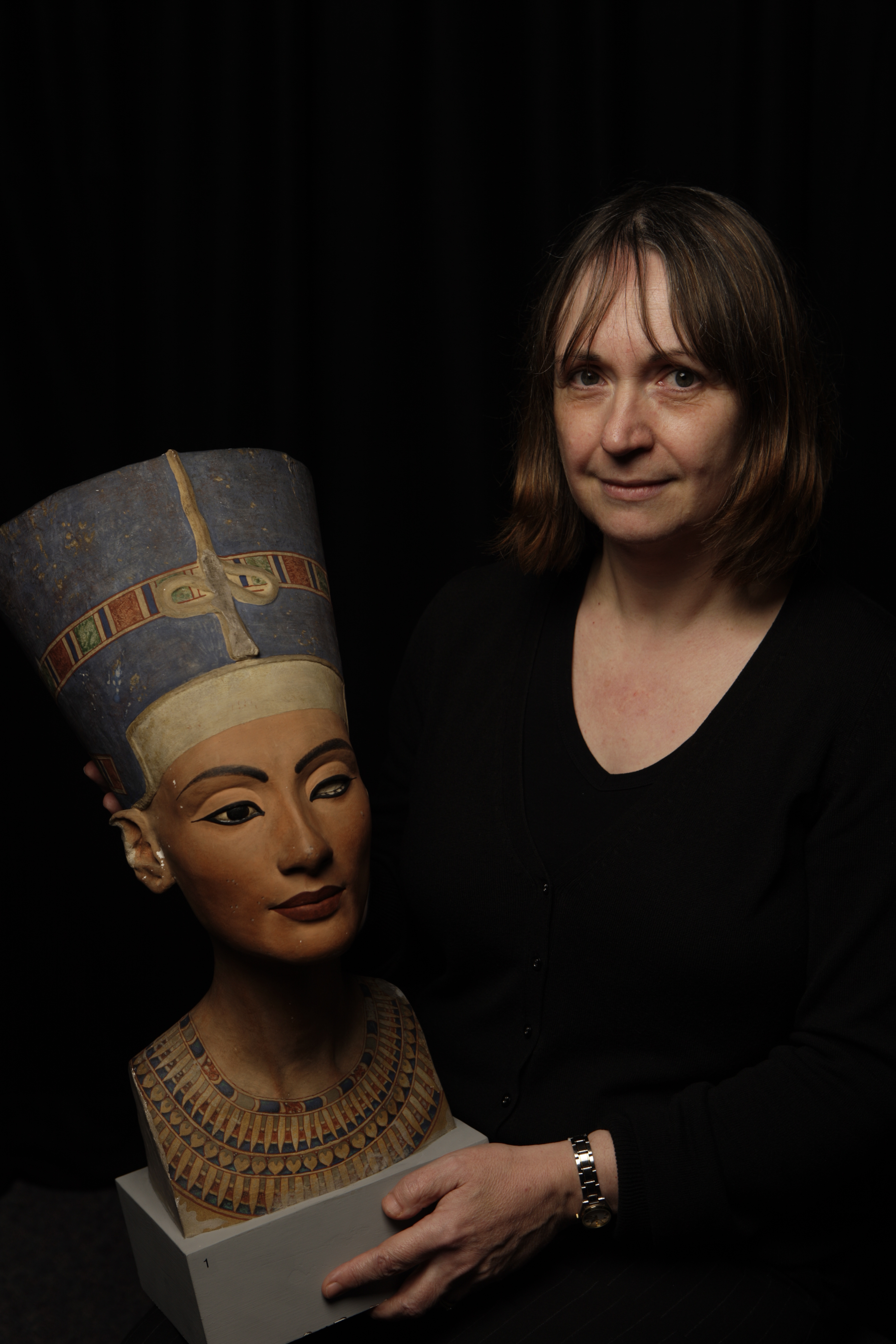|
Ramose And Hatnofer
Ramose was the father and Hatnofer the mother of Senenmut, one of the most important state officials under the reign of the Egyptian queen Hatshepsut in the Eighteenth Dynasty of Egypt. The commoner origins of Ramose and the rise of his son Senenmut were long considered to be prime examples of high social mobility in New Kingdom Egypt. For instance, almost nothing is known of Ramose's origins, but he seems to have been a man of modest means—anything from a tenant peasant or farmer, to an artisan or even a small landowner. When Ramose died he was a man aged 50–60 (based on the dental evidence).Peter F. Dorman, In: The Theban Necropolis, Past, Present and Future, p. 32, note 17 Hatnofer was an elderly lady, with grey or even white hair. They are believed to have been born at Armant, a town only south of Thebes within Upper Egypt presumably during the reign of Ahmose I, the founder of Egypt's illustrious 18th dynasty. Tomb of Ramose and Hatnofer Ramose is known from a few co ... [...More Info...] [...Related Items...] OR: [Wikipedia] [Google] [Baidu] |
Ramose
Ramose (Egyptian: ''wikt:rꜥ-ms, rꜥ-ms(.w)'') was an ancient Egyptian name, meaning "Ra is born". Variants of the name include Ramesses (Egyptian name), Ramesses (''Ramessu'') and Paramessu; these various spellings could be used to refer to the same person. Notable bearers of the name include: *Ramose (prince), Ramose, a son of Ahmose I *Ramose and Hatnofer: Senenmut's parents, Ramose, the father of Senenmut, Hatshepsut's highest state official *Ramose (vizier), Ramose, Amenhotep III's Vizier (Ancient Egypt), vizier (TT55) *Ramose (general), Ramose, a general from Amarna (Tombs of the Nobles (Amarna)) *Ramose (18th Dynasty), Ramose, a general from the end of the 18th Dynasty, buried at Saqqara *Ramose (TT7), Ramose, a scribe and artisan who lived during the reigns of Ramesses II References External linksTheban Tomb TT 71, Senenmut's parents Ancient Egyptian given names Theophoric names {{AncientEgypt-stub ... [...More Info...] [...Related Items...] OR: [Wikipedia] [Google] [Baidu] |
Senenmut
Senenmut ( egy, sn-n-mwt, sometimes spelled Senmut, Senemut, or Senmout) was an 18th Dynasty ancient Egyptian architect and government official. His name translates literally as "mother's brother." Family Senenmut was of low commoner birth, born to literate provincial parents, Ramose and Hatnofer (or "Hatnefret") from Iuny (modern Armant). Senenmut is known to have had three brothers (Amenemhet, Minhotep, and Pairy) and two sisters (Ahhotep and Nofrethor). However, only Minhotep is named outside chapel TT71 and tomb TT353, in an inventory on the lid of a chest found in the burial chamber of Ramose and Hatnofer. More information is known about Senenmut than many other non-royal Egyptians because the joint tomb of his parents (the construction of which Senenmut supervised himself) was discovered intact by the Metropolitan Museum in the mid-1930s and preserved. Christine Meyer has offered compelling evidence to show that Senenmut was a bachelor for his entire life: for instance ... [...More Info...] [...Related Items...] OR: [Wikipedia] [Google] [Baidu] |
Hatshepsut
Hatshepsut (; also Hatchepsut; Egyptian: '' ḥꜣt- špswt'' "Foremost of Noble Ladies"; or Hatasu c. 1507–1458 BC) was the fifth pharaoh of the Eighteenth Dynasty of Egypt. She was the second historically confirmed female pharaoh, after Sobekneferu. (Various other women may have also ruled as pharaohs or at least regents before Hatshepsut, as early as Neithhotep around 1,600 years prior.) Hatshepsut came to the throne of Egypt in 1478 BC. As the principal wife of Thutmose II, Hatshepsut initially ruled as regent to Thutmose III, a son of Thutmose II by another wife and the first male heir. While Thutmose III had inherited the throne at about two years old, Hatshepsut continued to rule by asserting her lineage as the daughter and only child of Thutmose I and his primary wife, Ahmose. Her husband Thutmose II was the son of Thutmose I and a secondary wife named Mutnofret, who carried the title 'King's daughter' and was probably a child of Ahmose I. Hatshepsut and Thutmos ... [...More Info...] [...Related Items...] OR: [Wikipedia] [Google] [Baidu] |
Armant
Armant ( ar, أرْمَنْت; egy, jwn.w-n-mnṯ.w or ''jwn.w-šmꜥ.w''; Bohairic: ; Sahidic: ), also known as Hermonthis ( grc, Ἕρμωνθις), is a town located about south of Thebes. It was an important Middle Kingdom town, which was enlarged during the Eighteenth Dynasty. It is located today in the Luxor Governorate on the west bank of the Nile. The ruined Temple of Hermonthis (sometimes Temple of Monthu) sits in the middle of the modern town. History The Ancient Egyptian name for the city meant "the Heliopolis of Montu", an Egyptian god whose root of name means "nomad". Montu was associated with raging bulls, strength and war. He was also said to manifest himself in a white bull with a black face, which was referred to as the Bakha. Egypt's greatest general-kings called themselves Mighty Bulls, the sons of Montu. In the famous narrative of the Battle of Kadesh, Ramesses II was said to have seen the enemy and "raged at them like Montu, Lord of Thebes". A tem ... [...More Info...] [...Related Items...] OR: [Wikipedia] [Google] [Baidu] |
Ahmose I
Ahmose I ( egy, jꜥḥ ms(j .w), reconstructed /ʔaʕaħ'maːsjə/ ( MK), Egyptological pronunciation ''Ahmose'', sometimes written as ''Amosis'' or ''Aahmes'', meaning "Iah (the Moon) is born") was a pharaoh Pharaoh (, ; Egyptian: ''pr ꜥꜣ''; cop, , Pǝrro; Biblical Hebrew: ''Parʿō'') is the vernacular term often used by modern authors for the kings of ancient Egypt who ruled as monarchs from the First Dynasty (c. 3150 BC) until the an ... and founder of the Eighteenth Dynasty of Egypt, classified as the first dynasty of the New Kingdom of Egypt, the era in which ancient Egypt achieved the peak of its power. He was a member of the Thebes, Egypt, Theban royal house, the son of pharaoh Seqenenre Tao and brother of the last pharaoh of the Seventeenth Dynasty of Egypt, Seventeenth dynasty, Kamose. During the reign of his father or grandfather, Thebes rebelled against the Hyksos, the rulers of Lower Egypt. When he was seven years old, his father was killed,#Shaw ... [...More Info...] [...Related Items...] OR: [Wikipedia] [Google] [Baidu] |
Heart Scarab Of Hatnefer MET Eg36
The heart is a muscular organ in most animals. This organ pumps blood through the blood vessels of the circulatory system. The pumped blood carries oxygen and nutrients to the body, while carrying metabolic waste such as carbon dioxide to the lungs. In humans, the heart is approximately the size of a closed fist and is located between the lungs, in the middle compartment of the chest. In humans, other mammals, and birds, the heart is divided into four chambers: upper left and right atria and lower left and right ventricles. Commonly the right atrium and ventricle are referred together as the right heart and their left counterparts as the left heart. Fish, in contrast, have two chambers, an atrium and a ventricle, while most reptiles have three chambers. In a healthy heart blood flows one way through the heart due to heart valves, which prevent backflow. The heart is enclosed in a protective sac, the pericardium, which also contains a small amount of fluid. The wall of th ... [...More Info...] [...Related Items...] OR: [Wikipedia] [Google] [Baidu] |
TT71
Theban Tomb TT71 is located in the Theban Necropolis, on the west bank of the Nile, opposite to Luxor. It was the tomb chapel of Senenmut, who was the steward and architect of Hatshepsut. The chapel is located in the necropolis area around Sheikh Abd el-Qurna. Previously (for about 100 years) the tomb was accessible and for most of this time the target of numerous investigations and intrusions, although early on already heavily destroyed. The tomb was visited already early. In the first half of the nineteenth century, John Gardner Wilkinson, Robert Hay and J. Wild copied scenes, although the decoration was already badly destroyed. Richard Lepsius (1842–45) took the false door to Berlin and copied some inscribed bricks. Only in 1906 Kurt Sethe copied all inscriptions. In 1930–31 Herbert Winlock cleared the whole tomb. Winlock found the fragments of a smashed sarcophagus. Today the tomb chapel's decoration is almost totally gone. With its dimensions it is one of the biggest ... [...More Info...] [...Related Items...] OR: [Wikipedia] [Google] [Baidu] |
Sheikh Abd El-Qurna
The necropolis of Sheikh Abd el-Qurna ( ar, شيخ عبدالقرنة) is located on the West Bank at Thebes in Upper Egypt. It is part of the archaeological area of Deir el-Bahari, and named after the domed tomb of the local saint. This is the most frequently visited cemetery on the Theban west bank, with the largest concentration of private tombs. Tombs * TT21 User, Scribe, Steward of king Thutmose I * TT22 Wah, later usurped by Meryamun * TT23 – Tjay * TT30 Khonsmose, Amun treasury official, Ramesside * TT31 – Khonsu * TT38 Djeserkaraseneb, Scribe, Counter of grain in the granary of the divine offerings of Amun * TT41 Amenemopet called Ipy, Amun temple high steward * TT42 Amenmose, Captain of troops, Eyes of the King in the Two Lands of the Retenu * TT43 Neferrenpet, Overseer of the kitchen (stores?) of Pharaoh * TT44 Amenemhab, wab-priest in front of Amun * TT45 Djehuty, Steward of high priest of Amun Mery * TT46 Ramose, Steward of the Mansion of the At ... [...More Info...] [...Related Items...] OR: [Wikipedia] [Google] [Baidu] |
Joyce Tyldesley
Joyce Ann Tyldesley (born 25 February 1960) is a British archaeologist and Egyptologist, academic, writer and broadcaster who specialises in the women of ancient Egypt. Life Tyldesley was born in Bolton, Lancashire and attended Bolton School. In 1981 she earned a first-class honours degree in the archaeology of the Eastern Mediterranean from Liverpool University. Her doctoral studies were undertaken at Oxford University; first at St Anne's College then, following the award of a scholarship, at St Cross College. In 1986 she was awarded a doctorate in Prehistoric Archaeology from Oxford University. Her thesis was written about Mousterian bifaces (handaxes) in Northern Europe. Tyldesley then joined the staff of Liverpool University, teaching Prehistoric Archaeology. Tyldesley then worked as a freelance Egyptologist/archaeologist; writing books, working with television companies, and teaching in further and higher education and online. Tyldesley has 2 children, Philippa and J ... [...More Info...] [...Related Items...] OR: [Wikipedia] [Google] [Baidu] |
Funerary Mask Of Hatnefer MET Vshatnofermask
A funeral is a ceremony connected with the final disposition of a corpse, such as a burial or cremation, with the attendant observances. Funerary customs comprise the complex of beliefs and practices used by a culture to remember and respect the dead, from interment, to various monuments, prayers, and rituals undertaken in their honor. Customs vary between cultures and religious groups. Funerals have both normative and legal components. Common secular motivations for funerals include mourning the deceased, celebrating their life, and offering support and sympathy to the bereaved; additionally, funerals may have religious aspects that are intended to help the soul of the deceased reach the afterlife, resurrection or reincarnation. The funeral usually includes a ritual through which the corpse receives a final disposition. Depending on culture and religion, these can involve either the destruction of the body (for example, by cremation or sky burial) or its preservation (for examp ... [...More Info...] [...Related Items...] OR: [Wikipedia] [Google] [Baidu] |





